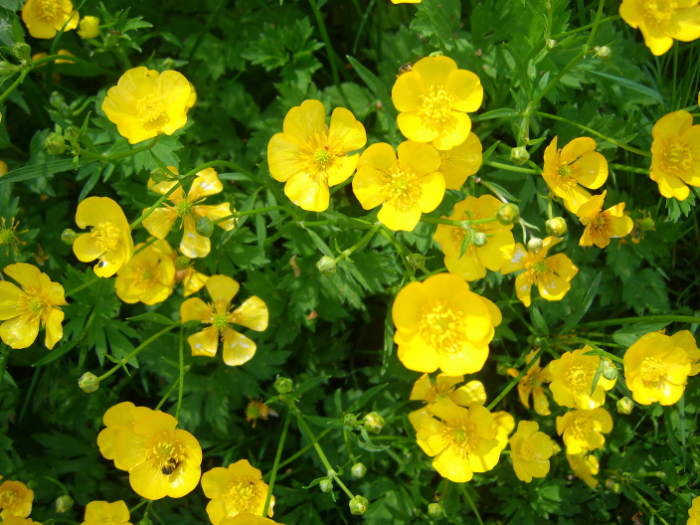Giant Hogweed
The giant hogweed does not have the word "giant" in its name for nothing. It can reach over 10 feet (3 m) in height. It is considered an invasive species since it grows so fast, and it may pose a risk to travelers that run into it.
Although its flowers may be kind to the eyes, the giant hogweed has a secret weapon – its sap. When it comes into contact with skin, it can cause photodermatitis or photosensitivity, two conditions in which the skin becomes very sensitive to sunlight and may develop blisters, pigmentation, and scarring upon exposure. This reaction, triggered by the sun's ultraviolet rays, will likely occur at least a day after the sap gets on the skin.
According to the New York Times, the giant hogweed is native to the Caucasus mountains in southwest Asia, but it was brought to the United States circa 1917 as an ornamental plant. This may sound puzzling, but this potentially harmful plant is truly impressive when fully grown – it is simply enormous. This makes it easy to identify and avoid, so we wouldn’t be too worried about an unsolicited accidental encounter with giant hogweed.
White Baneberry
The next feature on our list is not as toxic as giant hogweed because you need to ingest it to experience toxicity. Touching the leaves themselves is harmless, but come summer, this plant will flourish its creepy berries shamelessly and harm any animal and human that eats it.
Once fully mature, the berries seem like doll eyes on a stick, which is enough to give you the spooks. All parts of the plant are toxic, causing “a burning of the mouth and throat, salivation, severe stomach cramps, headache, diarrhea, dizziness and hallucinations.“ (Source)
The Gympie Gympie Stinging Tree
Just one swipe of the skin over this tree’s leaves can cause an allergic flareup that could last years and includes sneezing, running eyes and nose, an exceptionally painful rash, and hives. If it comes in contact with the eyes, it can cause temporary blindness.
The pain was described as, “the worst kind of pain you can imagine - like being burnt with hot acid and electrocuted at the same time.“ Another victim of the stinging tree described an unbearable pain that prevented him from sleeping for three days, “then it was pretty bad pain for another fortnight or so. This stinging persisted for two years and occurred every time I had a cold shower […] there’s nothing to rival it.”
Ranunculus
There are over 600 species in the genus of ranunculus, ranging from cut flowers fit for a bridal bouquet to invasive weeds that pose a threat to livestock. You probably had a bunch of buttercups in a vase at home at some point, but did you know this dainty flower is as poisonous to humans as it is to animals?
A slight bruise to this plant’s leaves is enough to release a chemical toxin that can cause burning, itching, rash, and blisters on the skin. If you ingest the leaves, you’ll develop blisters on your lips and face. This toxin is irritating to the eyes, although it won’t cause blindness. Ingested in large quantities, it will cause “abdominal pain, diarrhea and vomiting, dizziness and even paralysis.“ (Source)
What’s interesting, though, is that dried ranunculus has the medicinal properties of treating muscle aches and removing warts. A certain type of ranunculus called a bulbous buttercup (Ranunculus bulbosus) is considered “a potential famine food“ that can be eaten boiled.
Spurge Laurel
Also known as Daphne laureola, this evergreen shrub native to Eurasia, northern Africa, and the Mediterranean was imported to North America as a garden plant. It is commonly found under trees in forests, but don’t let its attractive looks deceive you – just two or three berries of this plant are enough to kill a child.
But you don’t have to go as far as ingesting the plant, as simply breathing in sap droplets is enough to cause poisoning. The toxins are found in the leaves and bark of the shrub, and handling it without protective equipment may cause contact dermatitis.
New Zealand Tree Nettle
Scientifically referred to as Urtica ferox, this plant is one of New Zealand’s most poisonous native plants. It is coated with white stinging hairs along its toothy leaves and stems. The plant can grow up to 6.5 feet in height, while its stinging hairs can extend up to a quarter of an inch.
Just like the Gympie Gympie stinging tree, a simple brush of bare skin against a plant is enough to cause poisoning. The white hairs will penetrate the skin and break, releasing a toxin that can cause temporary numbing. Full-body contact may cause sickness, loss of coordination, dizziness, and even death.

